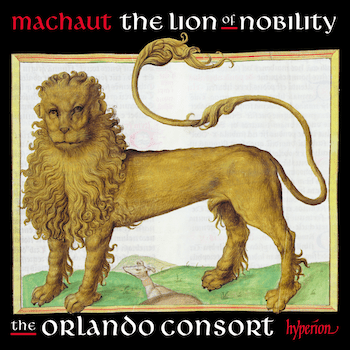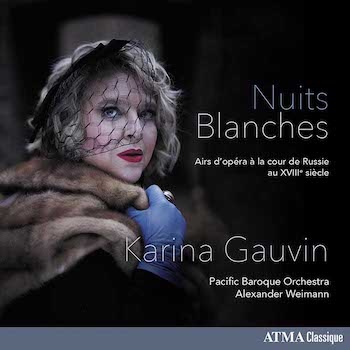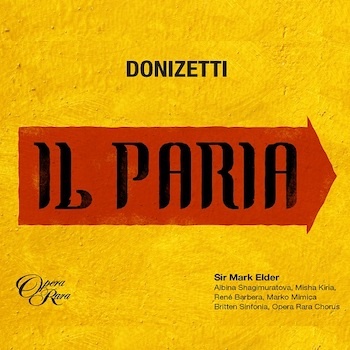Listening During Covid, Part 4: Fascinating Vocal Adventures from Different Times and Places
By Ralph P. Locke
I may be in quarantine, but music can transport me back to the Middle Ages, or to the court of Catherine the Great of Russia, or, via Donizetti, to an imagined India.
For music lovers possibly feeling trapped in their house or apartment, there is nothing quite like a brand-new recording of unusual music to freshen the air and the mind.
 This fourth installment of my “Listening During Covid” focuses on three brand-new CD releases, all featuring vocal music but of the most varied sorts. (Click here for installments 1, 2, and 3.)
This fourth installment of my “Listening During Covid” focuses on three brand-new CD releases, all featuring vocal music but of the most varied sorts. (Click here for installments 1, 2, and 3.)
I haven’t listened to much medieval music in recent years, so I somehow had missed discovering the Orlando Consort: four male singers who perform wonders. They have made many recordings of Renaissance music (e.g., by Loyset Compère) and medieval as well on the Hyperion label. Just released: their eighth recording devoted to the medieval poet and composer Guillaume de Machaut (c. 1300-77).
Machaut is a rare example of a highly skilled poet who also could compose with real skill. Some arguably parallel cases in recent years might be such diverse songwriters (and music-theater composers) as Hoagy Carmichael, Frank Loesser, Noel Coward, Bob Dylan, Paul Simon, Joni Mitchell, Jonathan Larsen (of Rent fame), and Lin-Manuel Miranda.
But, unlike any of these, Machaut is recognized foremost as a major poet, quite apart from the music to which he set the poems. One possible exception: Dylan finally won the Nobel Prize in Literature in 2016 and perhaps gets read “on the page” more than do — to mention two other names — Cole Porter or “Fats” Domino.
Maybe a better point of comparison would be Jean-Jacques Rousseau: his modest but effective short opera, Le devin du village (The Village Soothsayer, 1752), was at once a literary and a musical milestone. It has been recorded many times and continues to be studied in music-history courses and produced on stage. (The link I just gave leads to a CD/DVD preserving a recent imaginative, historically informed production at the opera house in Versailles.)
But, back to the Middle Ages! Machaut wrote monophonic (unison, single voice) tunes for some of his poems and polyphonic settings for others. Unlike many previous Machaut recordings by other performers, the Orlando Consort here uses no instruments: all we hear is a countertenor, two tenors, and a baritone, singing individually or in groups of two or three. The focus is thrown all the more on Machaut’s words, pitches, and dynamic rhythms. The pieces make frequent use of ternary rhythms (e.g., long short | long short | long) that bring a certain forward-moving and even jaunty flow to the melodic line.
The result is, by turns, delightful and absorbing. A monophonic ballade such as “Dame, se vous m’estes lonteinne” (“Lady, even though you are far away from me”) is so tuneful that I found myself beginning to hum along when it was only halfway done. It helps that significant stretches of the melody get repeated, consistent with the structure of the ballade and other “fixed” poetic forms of Machaut’s time.
The countertenor, Matthew Venner, has a lovely smooth sound, and it helps that the two tenors have highly contrasting vocal qualities, enabling one to pick out the different melodic lines with ease.
Machaut’s famous “Ma fin est mon commencement” (“My end is my beginning”) is here. Set at once as a rondeau with repeating sections and as a musical palindrome, this work features the two top voices singing the same melody: one from first note to last, the other (simultaneously) from last to first. Meanwhile, another palindrome is sung in the third voice, which sings a line to the middle of the piece and then reverses course, now singing the same melody “right to left.” Have fun seeing how much of this you can figure out by ear!
Particularly fascinating is the Consort’s treatment of the lengthy lai “En demantant et lamentant” (“With troubled mind and lamentation”), a lament presumably for King John II of France, hailed as the “lion of nobility,” from which the album takes its name. Scholars have figured out that, though it is written out as a one-voice piece with 12 stanzas, every three stanzas (e.g., stanzas 1-3, 4-6, 7-9, 10-12) can be performed simultaneously to create a full harmonic texture, almost in the style of a polytextual motet. The Consort has one singer sing the words of a given stanza while the others sing a neutral vowel (“ah” or sometimes, to my ear, a lovely French “eu”). This permits that stanza’s text to rise to the surface of the listener’s consciousness. It also, I notice, frees the “texted” performer to sing the words with special meaningfulness and intent, as if he is being accompanied by little more than some chords on a lute or a few wind instruments.
All in all, quite a fascinating trip through 14th-century France! The recording’s first-rate booklet-essay is available online for free, as are the sung texts and translation. Click here, where you can also listen to the beginning of each track.
 Now let’s fly ahead to 18th-century Russia! The country has age-old traditions of folk music and Orthodox religious chant. But there was little art music analogous to the Renaissance and early-Baroque masterpieces of, say, Palestrina or Schütz. Only in the 1700s, thanks in large part to the influence of various empresses (Anna, Elizaveta, and especially Catherine the Great), did opera and concert music begin to flourish, and important opera composers (such as Cimarosa, Galuppi, and Paisiello) began to be welcomed for long, well-paid residencies at the court theater in St. Petersburg.
Now let’s fly ahead to 18th-century Russia! The country has age-old traditions of folk music and Orthodox religious chant. But there was little art music analogous to the Renaissance and early-Baroque masterpieces of, say, Palestrina or Schütz. Only in the 1700s, thanks in large part to the influence of various empresses (Anna, Elizaveta, and especially Catherine the Great), did opera and concert music begin to flourish, and important opera composers (such as Cimarosa, Galuppi, and Paisiello) began to be welcomed for long, well-paid residencies at the court theater in St. Petersburg.
Canadian soprano Karina Gauvin, whom I have previously admired in Mozart, Spontini, and Debussy, has now released an imaginative disc of excerpts from operas performed in Russia in the 1700s. (Cecilia Bartoli released a similar CD in 2014, with quite different repertory. Critics reported that her singing was hyper-intense and the coloratura, by this point in her career, too approximate.) We hear five significant chunks of Gluck’s Armide (1777) and arias by the two most important composers born in the Russian Empire before Glinka: Bortniansky and Berezovsky. Plus overtures by Bortniansky and Fomin. (The CD booklet spells Slavic names the French way: e.g., Fomine.) Plus a Sinfonia cossaca (Cossack Overture) by Domenico Dall’Oglio. The two B’s were born in Glukhov (now called Hlukhiv, in Ukraine), Fomin was from St. Petersburg, and Dall’Oglio was a minor Italian musician hired to the Russian court to provide instrumental music for social gatherings.
The items here composed by the three local composers are all capably put together—better constructed, in fact, than Dall’Oglio’s rather inept (if mildly intriguing) attempt at writing an overture evoking Slavic style. Bortniansky’s overture and aria from Le faucon (1786) are very solid, and similar in style to what Grétry was writing around the same time, such as his Raoul Barbe-Bleue (1789). The Fomin overture (to Les cochers au relais, i.e., The Stagecoaches at the Relay Station; 1787) is likewise a well-crafted example of opéra-comique style, reminding us that Russian aristocrats spoke French to each other and dressed in the latest Paris fashion. The excerpts from Bortniansky’s Alcide (1778) and Berezovsky’s Demofoonte (1773) are fine examples of Italian opera seria, much in the manner of the aforementioned Paisiello. (Both were actually written for performances in Italy, rather than Russia.)
Best of all, not surprisingly, are the five substantial excerpts from Gluck’s Armide (1777, reusing most of the libretto of Lully’s famous opera from 1686!). Gluck’s insistence on making the music suit the dramatic situation is repeatedly evident here, as is his imaginative use of the orchestra. The keening oboe over agitated figures in the string orchestra in “Oh! ciel, quelle horrible ménace!” shows where Berlioz got certain of his ideas for using an orchestra to express distinct emotional states (in the Symphonie fantastique and other works), and the “Gratioso (minuet)” movement is as delicate and touching as any dance movement by Mozart.
Karina Gauvin sings magnificently throughout, with remarkably steady tone, though she is now in her early 50s—an age by which many other singers have become overemphatic or wobbly. She responds with alacrity to the texts, and can narrow the voice down to a golden thread that has the listener hanging on each note. I just love her casual way of tossing off trills, yet she can imbue coloratura with substantial dramatic intensity when she chooses. If the Russian aristocrats had singers half as wonderful, they were lucky indeed! It surely helps that Gauvin has sung in a staged production of this very Gluck opera (at Netherlands Opera).
The Vancouver-based Pacific Baroque Orchestra, led from the fortepiano by Alexander Weimann, plays beautifully. The varied colors of their period instruments help transport us back to the decades that preceded, and led to, what is sometimes called the Golden Age of Russian culture (the age of Pushkin, Glinka, and so on). Excerpts from this “Russian” CD can be heard here. Subscribers to Naxos Music Library can also download the wonderful booklet, with its informative essay, based on important research by Israeli musicologist Marina Ritzarev.
 Our last stop is India, or rather an India-of-the-imagination, as cooked up in 1829 by a youngish Gaetano Donizetti for the Teatro San Carlo in Naples. The opera did not remain long in the repertory, for reasons having nothing to do with its musicodramatic cogency, and Donizetti plundered bits of it to use in various later operas (including Le duc d’Albe, for Paris).
Our last stop is India, or rather an India-of-the-imagination, as cooked up in 1829 by a youngish Gaetano Donizetti for the Teatro San Carlo in Naples. The opera did not remain long in the repertory, for reasons having nothing to do with its musicodramatic cogency, and Donizetti plundered bits of it to use in various later operas (including Le duc d’Albe, for Paris).
Now the musicologists Roger Parker and Ian Schofield have reconstructed the score and brought it to the enterprising record company Opera Rara, who hired pretty much the best singers and conductor around in order to show the world what Il paria has to offer.
Wow, the thing is spiffy!: mellifluous melodies, sometimes florid, sometimes more stentorian in a proto-Verdian way, and lots of energetic accompaniment from the orchestra (with surprising colors such as a harp to emphasize the “ray of hope” of which the heroine sings in the cabaletta to her first aria—CD 1, track 8).
One of my favorite moments is for the hero’s father, whom we meet while he is in prayer, to a tune (CD 1, track 11) that is folklike in the manner of Cinderella’s sad fireside song in Rossini’s La Cenerentola. But the duets and big ensembles are as masterfully handled as in better-known operas by Donizetti, such as Lucia di Lammermoor and Roberto Devereux.
The singers help enormously to put the work across. Albina Shagimuratova reminds us why she is in such demand in leading coloratura roles at the Met and elsewhere. René Barbera brings glowing fervor to the role of Idamore. And Misha Kiria makes a properly resonant noise as his (aforementioned) father, though his low notes (as so often with basses nowadays) are not strong. He easily throws in an unwritten high note, suggesting that his voice lies a little higher than what the role most demands.
Mark Elder, who received plaudits galore for his previous Donizetti recording, L’ange de Nisida (likewise on Opera Rara), pulls the whole show together tautly yet flexibly. The Britten Sinfonia sounds like a pit orchestra, but a particularly alert and colorful one, adding to the theatrical flavor.
What does India have to do with the plot? Well, this is one of those 19th-century operas that argues powerfully for tolerance of religious or ethnic difference but protects the librettist and composer from criticism by setting the whole plot far from home, or in the distant past, or (as here) both: locating the work in 16th-century India allowed it to critique social prejudice against members of a lower caste (the “pariah” family of the opera’s title, including the main tenor and baritone roles). The result is a work that still speaks to issues in our life today.
Synopsis and track list can be found here, and you can hear the beginning of each track. The recording can be heard through the usual streaming services (as can the two recordings reviewed above, though I can’t find the Machaut in Spotify). But to get the libretto for Il paria, you have to purchase the recording (either as a CD or download).
I heartily recommend any or all three of these new releases as ways to travel in the imagination to different times and places, and to think about the roles that music and the arts can play in human life and society—then and there, and here and now.
Ralph P. Locke is emeritus professor of musicology at the University of Rochester’s Eastman School of Music. Six of his articles have won the ASCAP-Deems Taylor Award for excellence in writing about music. His most recent two books are Musical Exoticism: Images and Reflections and Music and the Exotic from the Renaissance to Mozart (both Cambridge University Press). Both are now available in paperback; the second, also as an e-book. Ralph Locke also contributes to American Record Guide and to the online arts-magazines New York Arts, Opera Today, and The Boston Musical Intelligencer. His articles have appeared in major scholarly journals, in Oxford Music Online (Grove Dictionary), and in the program books of major opera houses, e.g., Santa Fe (New Mexico), Wexford (Ireland), Glyndebourne, Covent Garden, and the Bavarian State Opera (Munich). A version of this review first appeared in American Record Guide and here appears by kind permission.
Tagged: " Opera Rara, ATMA Classique, Donizetti, Guillaume de Machaut, Hyperion, Il paria, Karina Gauvin, Ralph P. Locke
